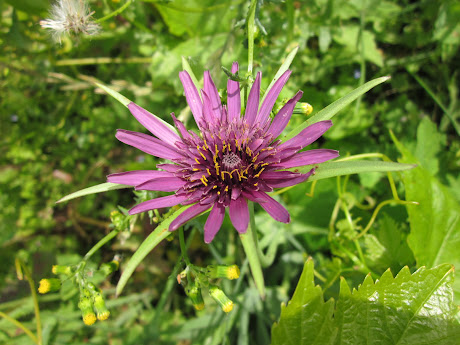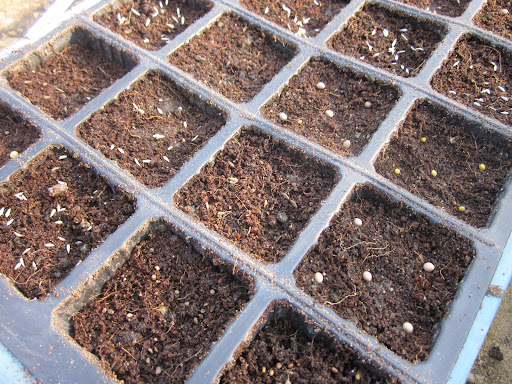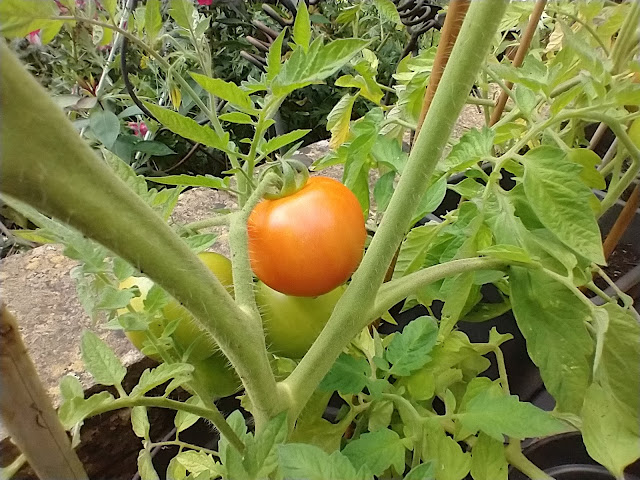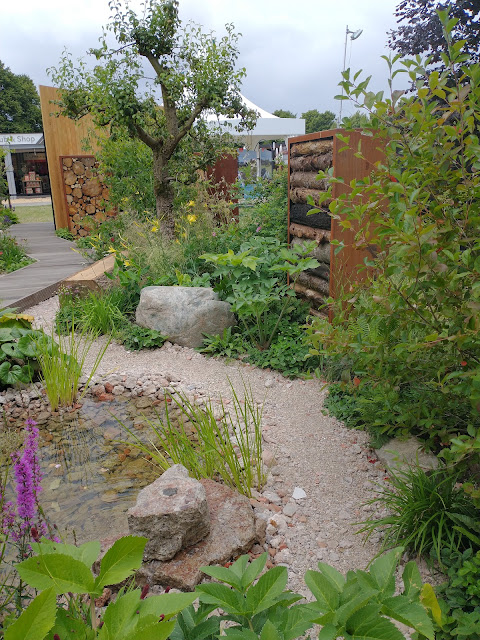Plants for Bugs
 |
| A comma on non-native Verbena bonariensis in my garden this week - it was there for over an hour |
In May 2012 I wrote in my Secret Wisley entry:
"... I was taken on a tour of one of the Plants for Bugs trials sites: it was so fascinating I'm saving the details for another post."
How time flies... I've kept some secrets for a little longer than planned. Tucked away in a not-so-much-visited corner of Wisley I saw this:
 |
| Part of the Plants for Bugs trials area at RHS Wisley, May 2012 |
The RHS released the first news of their research results last week, so at last it's time to tell you more. The key message for gardeners here in the UK is:
"Don't get too hung up on keeping to solely native plants; choose from a wider planting palette - particularly species from the northern hemisphere - to encourage more insects and other invertebrates into your garden."
From the thousands of invertebrates collected during the study, around 300 different species were identified. The research also showed pollinators may not choose native plants as their first-choice to visit. In addition, growing a wide mix of plants originating from around the globe extends the season of availability of important food sources such as nectar and pollen.
I think there's further good news for UK gardeners because
- Our choice of native plants is relatively small - approximately 1,400 species, with around a further 1,300 classed as naturalised (source: JNCC). Our gardens wouldn't be half as interesting if we stuck to just our native flora.
- Invertebrates are towards the bottom of the food chain, so if their population is a healthy one it's good news for the other wildlife that visits our gardens to feast on a tasty snack or three.
- I grow a broad mix of plants from many countries, so my garden's wildlife population has a better chance of being diverse and in balance. There is less chance of any pest - such as aphids - having a population explosion which in turn overwhelms my plants.
 |
| A planting plan for a native plants trials plot - other plots had solely non-native (northern hemisphere in origin) or exotic (southern hemisphere in origin) plants |
I had a think about the native and non-native plants in my garden after my Wisley visit, and I guessed correctly what the result might be. Many of the wildlife-friendly plants which sprang to my mind don't hail from these shores e.g. Buddleja aka butterfly bush. However, it's good to see the science has proved my notion, and it's interesting to note there's a difference in the results with plants chosen from the northern and southern hemispheres.
I've enjoyed watching the many invertebrate visitors to my garden this year and I'm planning on showing you some of them in a later post. I've seen quite a few insects for the first time - I think my woolly lawn might have helped...
 |
| Neatly labelled plots - it was a very cold spring in 2012, hence the lack of colour. We were told that growth was about 3 weeks behind the norm at the time of our visit. |
Note: the results may not be transferable elsewhere
Veg Plotting's non-UK readers - particularly from across the pond - may question these results as gardeners in the USA are often actively encouraged to focus on native species *. This is largely in response to:
- Some non-native plants which are proving to be invasive e.g. the garlic mustard I wrote about for June's Blooms Day.
- Gardeners are also encouraged to provide the right habitat and native plants for key species like the monarch butterfly along its migratory path.
Whilst our definition of native is probably similar - plants which have arrived and established in a country without the intervention of man - our timeframes are different. In the UK we usually mean plants which were here at the end of the ice age 10,000 years ago, whilst in the States it's much later, at around the time of Columbus.
The total number of plants native to the USA is more than ten times greater than the UK's at nearly 19,000, though these numbers are probably reduced at State level, owing to the variation in plant hardiness zones across the country. It means Stateside gardeners already enjoy a wider mix of plants to choose from within their native flora.
* it's probably the wide availability of support materials and articles aimed at USA gardeners online which has helped persuade some of us in the UK that focusing on native plants is better for our gardening too. That's why research such as Plants for Bugs is important as it helps us make better informed decisions.
 |
| The main information board at the research area, showing the layout and some of the collection methods |
Note: this isn't the complete picture
Gail's left a great comment about the importance of trees in our garden mix. For example, our native oak hosts hundreds of insect species, and that's just for starters. The Plants for Bugs study focused mainly on perennials and grasses, plus a few shrubs. I wonder what the results would be if our native trees, shrubs and other plants such as bulbs were compared with their non-native cousins.
However, I'm not suggesting we all start growing oak trees in our gardens as they're too large for most plots. A study of the smaller garden-worthy trees would be helpful and I'm a huge advocate of growing at least one tree in every garden. The RHS has a couple of lists of suggestions for trees and shrubs for your consideration: Trees for smaller gardens, and Trees and shrubs: native to the UK.
My friend Gail's blog, Clay and Limestone is worth a read and note she hosts Wildflower Wednesday every fourth Wednesday in the month. It's a celebration of all wildflowers from around the world.
And then... there are other factors to consider, such as:
As with much of life, there aren't really any simple ways to ensure 100% success with gardening, but on balance I believe the key message from Plants for Bugs is a good starting point.
And then... there are other factors to consider, such as:
- Single vs double flowers and how plant breeding for showier, often double blooms may affect the availability and accessibility of nectar and pollen.
- The specific plants insects like the holly blue butterfly need to complete their lifecycle.
- The influence of factors such as habitat, height above sea level, aspect, soil etc. - these variables would have to be eliminated as far as possible in the RHS's study so the full impact of the 3 plant types they looked at could be compared. However, as a gardener I'm happy to vary the number of conditions (e.g. damp, dry, shady etc.) in order to grow a wider variety of plants and to attract more wildlife.
As with much of life, there aren't really any simple ways to ensure 100% success with gardening, but on balance I believe the key message from Plants for Bugs is a good starting point.
Further Reading
Links to the RHS's Plants for Bugs project:
- Plants for Bugs main website page
- Plants for Bugs project description
- Plants for Bugs first results report page (includes a link to the first paper published from this project in the Journal of Applied Ecology)
- RHS's Plants for Bugs blog posts by Helen Bostock (who kindly showed me around in 2012; thanks also to lead entomologist Andrew Salisbury, who demonstrated some of the collection methods.)
- PDF Plants for Bugs interpretation bulletin for gardeners (recommended)
- PDF List of plants used in the project
- PDF Plants for Bugs leaflet (recommended)
Other reading which may be of interest:
The RHS's Perfect for Pollinators page has links to 3 PDF lists to help us choose the best nectar and pollen-rich plants for our gardens. I wrote a post a while ago on the bee-friendly plants I've found do particularly well in my garden. Since then, I've found Agastache, Knautia, Echinops and thyme are good for all kinds of insects in addition to the Verbena bonariensis shown at the top of this post.
It's great we can grow such a wide variety of plants, but that doesn't necessarily mean we should grow all of them. Here's Plantlife's guidance page on invasive non-native plants in the UK. NB some familiar plants such as Cotoneaster horizontalis are included.
It's great we can grow such a wide variety of plants, but that doesn't necessarily mean we should grow all of them. Here's Plantlife's guidance page on invasive non-native plants in the UK. NB some familiar plants such as Cotoneaster horizontalis are included.
Here's a list of invasive species I've found for the USA - you'll see there's plenty on there which we welcome here, such as ox-eye daisy. Verbena bonariensis, the loved-by-many-a-UK-gardener-and-insect-alike plant shown at the top of this post is on the invasive watchlist for Washington State.










An interesting, and informative, post. Just about all the flowers I grow on the plot are with bugs in mind.
ReplyDeleteFlighty xx
Thanks Flighty - I keep it in mind for my plant choices too.
DeleteA fascinating fact about verbena bonariensis, which I've grown for the first time this year. It's really interesting to learn that non-native plants are perfectly acceptable for insects. A most informative post, thank you.
ReplyDeleteIt's not just butterflies getting drunk on my Verbena boniariensis this year CJ, it's attracting all kinds of insect visitors which I can watch buzzing around the plants whilst I'm eating in our kitchen. It's a fabulous view. Not all non-natives are acceptable - as indeed applies to natives - it depends more on the whether they're simple flowers and the availability of the nectar etc. Then of course, there are those specialist cases where only one plant will do for a particular insect, which may be good for nothing for anything else. It's a more complicated picture, but at least we now know that planting a wide-variety of plants is a simple way of ensuring a good mixture of garden visitors :)
DeleteEnjoyed the post ...a lot! I plant non-native to my eco-region plants (but native to Eastern Tennessee, the Central US and Southeastern US) and luckily for me these plants haven't proven invasive. I am thrilled that they attract pollinators and other invertebrate species. What I remind folks around here is don't forget trees, they're super host plants. gail
ReplyDeleteGood point Gail, our native oak tree is host to hundreds of species. I wonder what a research project would find if native vs non-native trees would find. I'll update my post with this thought, thank you :-)
DeleteThst should read... If native vs non-native trees were compared
DeleteThanks for the linklove and shout out about Wildflower Wednesday! xo
DeleteMy pleasure Gail - I have a post-Fling entry for Wildflower Wednesday to write up sometime :)
DeleteI'm so glad I didn't post at the time... it would have been a 'hey this is really interesting and I loved my visit, but watch this space for the results' kinda post ;)
ReplyDeleteI try to have different shapes and colours of flowers and also have as long a season as possible/
ReplyDeleteDo they include cabbages, carrots etc.:)
Hi Sue - no it was only herbaceous perennials. There's a link to the planting list in the resources at the end if you're interested.
DeleteI'm amazed at what carrots and leeks attract when they're allowed to flower.
Very informative, Michelle. My garden has a mix of native and non-native plants--more non-natives near the house (anything that isn't invasive and that the rabbits don't like to eat), with more native plants the further one moves from the house. Many non-natives definitely have wildlife value, as long as they aren't invasive. I didn't realize the U.S. had so many more native plants than the U.K., but I suppose part of that is the geographic size of the country. Thanks for all the great info!
ReplyDeleteYou're welcome Beth :) Interesting point about the difference in size between our 2 countries, sometimes islands can be more diverse e.g The Gallapagos. For some reason it's not happened for us - perhaps factors such as climate and our proximity to the continent (or even our relatively recent isolation from the rest of Europe) come into play...
DeleteInteresting post - and I think the key message for me here is to grow the plants I love, which is great news :) #hdygg
ReplyDeleteYes, it's great news :-)
DeleteWe have similar experiments set up in both Dubai and South Africa and I saw bug tents in Canada when I visited last month
ReplyDeleteOoh that's interesting, do you know if any results have been published yet?
DeleteYou've reminded me one of my Twitter correspondents in Canada has given me some references to the research there, I must add them to this post.
Goodness me, this is very informative! I've always taken a "scatter and see" approach to gardening, so far the bugs seem to like my style!
ReplyDeleteThanks Amanda. I like the sound of your approach to gardening. W e can learn much from our own observations, which is a common theme here on this blog :-)
Delete